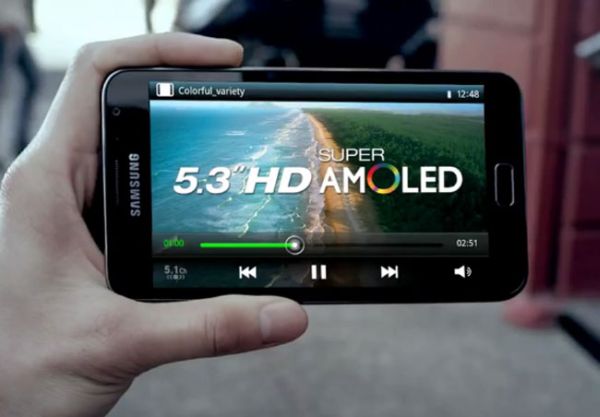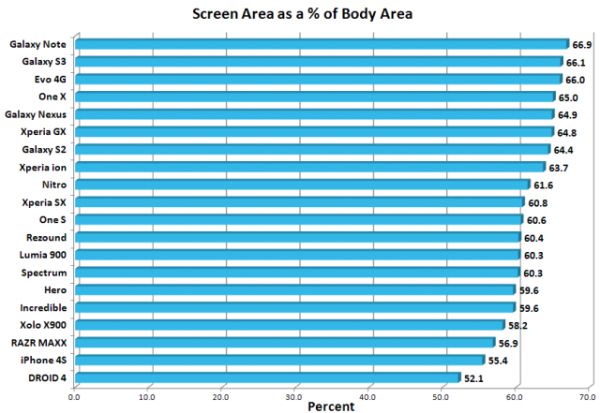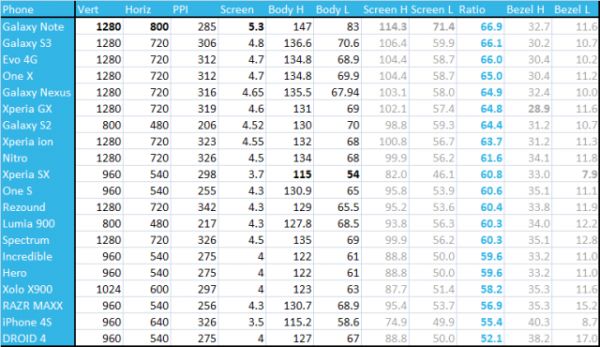Affiliate links on Android Authority may earn us a commission. Learn more.
Galaxy Note is smartphone with best screen-to-body size ratio, S3 follows closely
Published onMay 25, 2012

Not long ago it seemed like a mobile phone’s most important target was to be as slim, light and portable as possible. But recently, tech users have started changing their views on the market. They now look for phones with the largest and brightest screens, first and foremost.
However, a display’s size could be deceiving sometimes, as there are still a multitude of phones featuring large bezels and/or physical buttons and therefore restricting the actual usable space on the screen. That’s why we were relieved to bump into a chart compiled by Reddit user, Thare, who compiled some information on this specific topic. He analyzed the screen-to-body size ratios of some of the best Android smartphones these days.
In other words, the graph shows figures that represent how much of the total area of a smartphone’s front side is covered by the actual display. Not surprisingly, the #1 phone ranked in the chart is not exactly a phone, but Samsung’s Galaxy Note phablet.
The Note has 66.9% of its body area made out of touch-screen, which might not be impressive at a first glance, but it’s actually a lot better than what many popular smartphones these days have to offer, including the iPhone 4S, Motorola Droid RAZR MAXX or HTC’s One S.

Then again, we have to notice that, if the best phone out there (or phablet) only uses a tad over two-thirds of body area for “honorable” purposes, there is clearly room for improvement. It would be difficult to imagine a phone using 100% of its body to display images and videos (unless we’re talking about devices with flexible screens, of course). But we could see it a possibility for the manufacturers to soon come up with gadgets using 80 or 90% of their measurements for solely screen space and usage.
Just think of what it would mean for the Galaxy Note to keep its current profile, but feature a 5.7″ or even 6″ display! I know, it sounds crazy, but it could be possible with the diminishing of the horizontal bezel. This part to be honest, is not very functional for most regular users anyways.
Getting back to the chart posted on Reddit, we should tell you that the Galaxy Note is followed very closely by the newly unveiled Galaxy S3, with a nice 66.1% screen-to-body size ratio, while the bronze medal is claimed by the HTCEVO 4G LTE (incorrectly referred to as the “EVO 4G” in the chart), with a 66% ratio.

HTC’s One X, the Galaxy Nexus, Sony’s Xperia GX and the Galaxy S2 are the next few phones to top the rank, while at the bottom we can find the Droid 4, with almost 48% of body space “wasted”, the iPhone 4S, with a rather mediocre 55.4% screen-to-body size ratio, and the Droid RAZR MAXX, with 56.9% of its body used wisely.
What’s interesting is that a PhoneArena reader, going by the name of Franc, has decided to do some calculations and come up with a few numbers himself and has found Panasonic’s Eluga Power a much better “space-saver” than the Galaxy Note.
The Power supposedly uses no less than 72.29% of its total body in displaying purposes and is followed by the HUAWEI Ascend D Quad XL, who overtakes the Note by a whisker, with a 67.38% screen-to-body size ratio.
What do you guys think of these calculations? Does bigger always mean better? Do you see the smartphone screen-to-body size ratio going significantly up in the near future? Let us know in the comments section below!